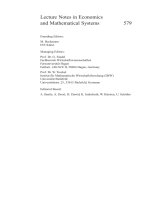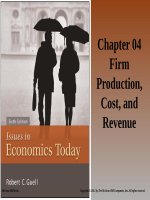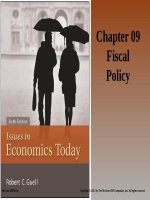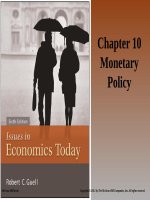Lecture Issues in economics today - Chapter 32
Bạn đang xem bản rút gọn của tài liệu. Xem và tải ngay bản đầy đủ của tài liệu tại đây (241.14 KB, 14 trang )
Chapter 32
Farm Policy
McGrawHill/Irwin
© 2002 The McGrawHill Companies, Inc., All Rights Reserved.
Chapter Outline
• FARM PRICES SINCE 1950
• PRICE VARIATION AS A JUSTIFICATION
FOR GOVERNMENT INTERVENTION
• CONSUMER AND PRODUCER SURPLUS
ANALYSIS OF PRICE FLOORS
• PRICE SUPPORT MECHANISMS AND
THEIR HISTORY
McGrawHill/Irwin
© 2002 The McGrawHill Companies, Inc., All Rights Reserved.
Farm Prices Since 1950
• Raw food commodity prices have increased
much more slowly than overall inflation.
• From 1982 to 1998 overall inflation was 68%.
• Most food commodities cost less in 2000 than
in 1982 in nominal terms (40% less in real
terms.)
• Hog prices in 2000 yielded less than 40% of
their 1982 levels.
McGrawHill/Irwin
© 2002 The McGrawHill Companies, Inc., All Rights Reserved.
P r ic e In d e x ( 1 9 8 2 = 1 0 0 )
Farm Price Inde
1982=100
180
160
140
120
100
80
60
40
20
1950
1955
1960
1965
1970
1975
1980
1985
1990
Year
McGrawHill/Irwin
Corn
Beef
hog
Soybea
Milk
CPI
© 2002 The McGrawHill Companies, Inc., All Rights Reserved.
Price Variability as the Justification
for Government Intervention
• Argument for intervention on this
ground
– Highly variable prices create an unstable
income for farmers reducing their interest
in farming.
• Argument against intervention on this
ground
– Using options markets and crop insurance
farmers can dampen the impact of this
variability.
McGrawHill/Irwin
© 2002 The McGrawHill Companies, Inc., All Rights Reserved.
Price Floors
• A Price Floor (a price below which a
commodity may not sell) is set to
protect farmers from prices that go “too
low.”
McGrawHill/Irwin
© 2002 The McGrawHill Companies, Inc., All Rights Reserved.
Farm Markets Without Subsidies
P
•
S
A
•
•
P*
•
C
•
H
Value to the Consumer:
• 0ACQ*
Consumers Pay Producers:
• OP*CQ*
The Variable Cost to Producers:
• OHCQ*
Consumer Surplus:
• P*AC
Producer Surplus:
• HP*C
D
McGrawHill/Irwin
Q*
Q/t
© 2002 The McGrawHill Companies, Inc., All Rights Reserved.
Price Floors
P
S
A
Pfloor
•
Value to the Consumer:
• 0ABQD
•
Consumers Pay Producers:
• OPfloorBQD
•
The Variable Cost to Producers:
• OHGQD
•
Consumer Surplus:
• PfloorAB
•
Producer Surplus:
• HPfloorBG
•
DWL
• BEC
B
Price Floor
P*
C
G
H
D
McGrawHill/Irwin
QD Q*
Q/t
© 2002 The McGrawHill Companies, Inc., All Rights Reserved.
Government Purchase of
Excess Goods
P
S
A
B
Pfloor
P*
E
I
•
Consumers Pay Producers:
• OPfloorBQD
•
Government Pays Producers:
• QDBEQs
•
The Variable Cost to Producers:
• OHEQS
•
Consumer Surplus:
• PfloorAB
•
Producer Surplus:
• HPfloorE
•
DWL
• ECF
C
H
F
J
Value to the Consumer:
• OABQD
Price Floor
G
McGrawHill/Irwin
•
D
QD Q*
QS
Q/t
© 2002 The McGrawHill Companies, Inc., All Rights Reserved.
P
Government Lowers the Price
to Consumers
• Value to the Consumer:
A
B
Pfloor
P*
• OAFQS
S
E
•
Consumers Pay Producers:
• OJFQS
•
Government Pays Producers:
• JPfloorEF
•
The Variable Cost to Producers:
• OHEQS
•
Consumer Surplus:
• JAF
Producer Surplus:
• HPfloorE
Price Floor
I
C
G
H
•
F
J
D
QD Q*
McGrawHill/Irwin
QS
•
Q/t
DWL
• ECF
© 2002 The McGrawHill Companies, Inc., All Rights Reserved.
Variable Floors
• The Eau Claire Rule: the wholesale
price floor on milk is set as a function of
the distance between a given
community and Eau Claire, Wisconsin.
• This subsidizes milk production on the
coasts of the United States.
McGrawHill/Irwin
© 2002 The McGrawHill Companies, Inc., All Rights Reserved.
What Would Happen Without
Price Floors
• Prices would fall.
• Production would fall.
• Farmers would leave the industry until
the price of commodities reached a
level consistent with zero economic
profit (normal profit).
McGrawHill/Irwin
© 2002 The McGrawHill Companies, Inc., All Rights Reserved.
History of Price Supports:
Buying programs
• Began in the 1930s.
• Reached a peak in the 1980s.
• The federal government purchased vast
quantities of corn, soybeans, milk to be
stored. The milk was powdered or turned into
blocks of American Cheese.
• The cheese given away to the poor in the
1982 recession (which was the origin of the
phrase “government cheese”.)
McGrawHill/Irwin
© 2002 The McGrawHill Companies, Inc., All Rights Reserved.
History of Price Supports:
Output Restrictions
• The buying programs were ended in the
1980s and were replaced with programs
where the government offered higher
prices for limited production.
• The programs
– purchased dairy herds and slaughtered
them.
– Ordered grain farmers to set aside plots if
they wanted the subsidized price.
McGrawHill/Irwin
© 2002 The McGrawHill Companies, Inc., All Rights Reserved.









